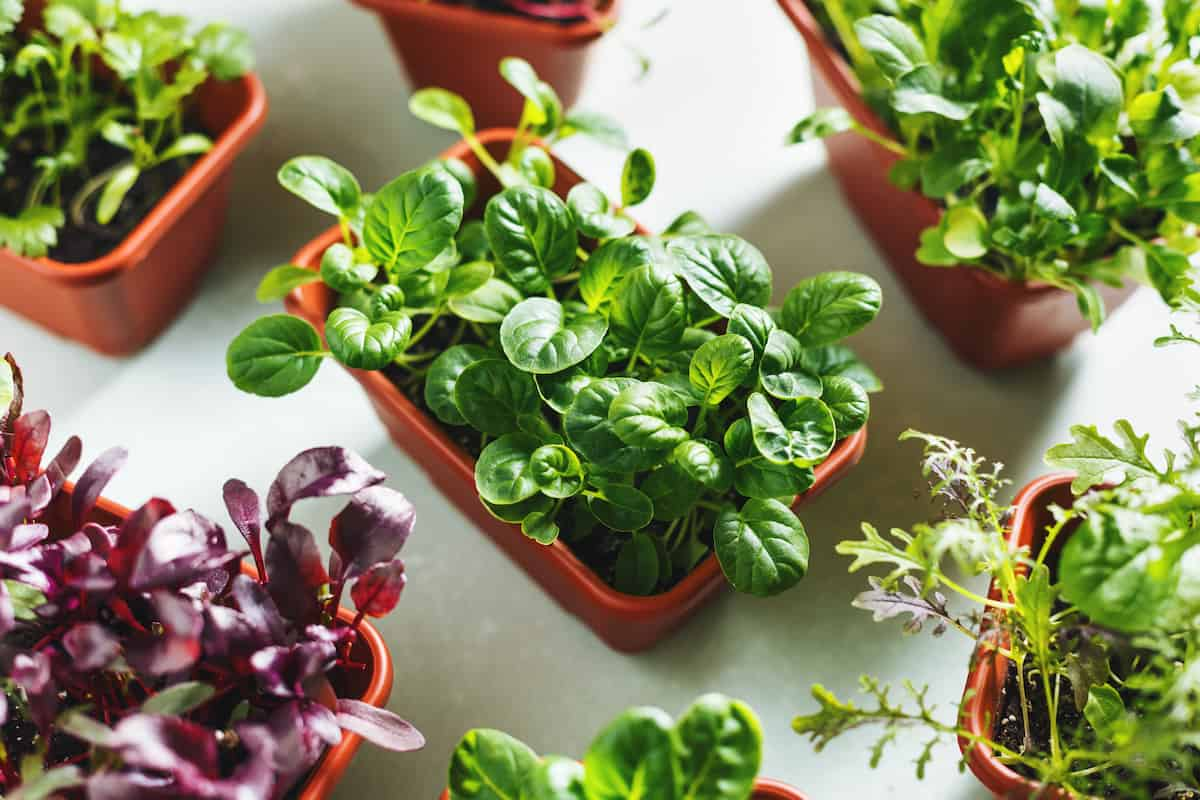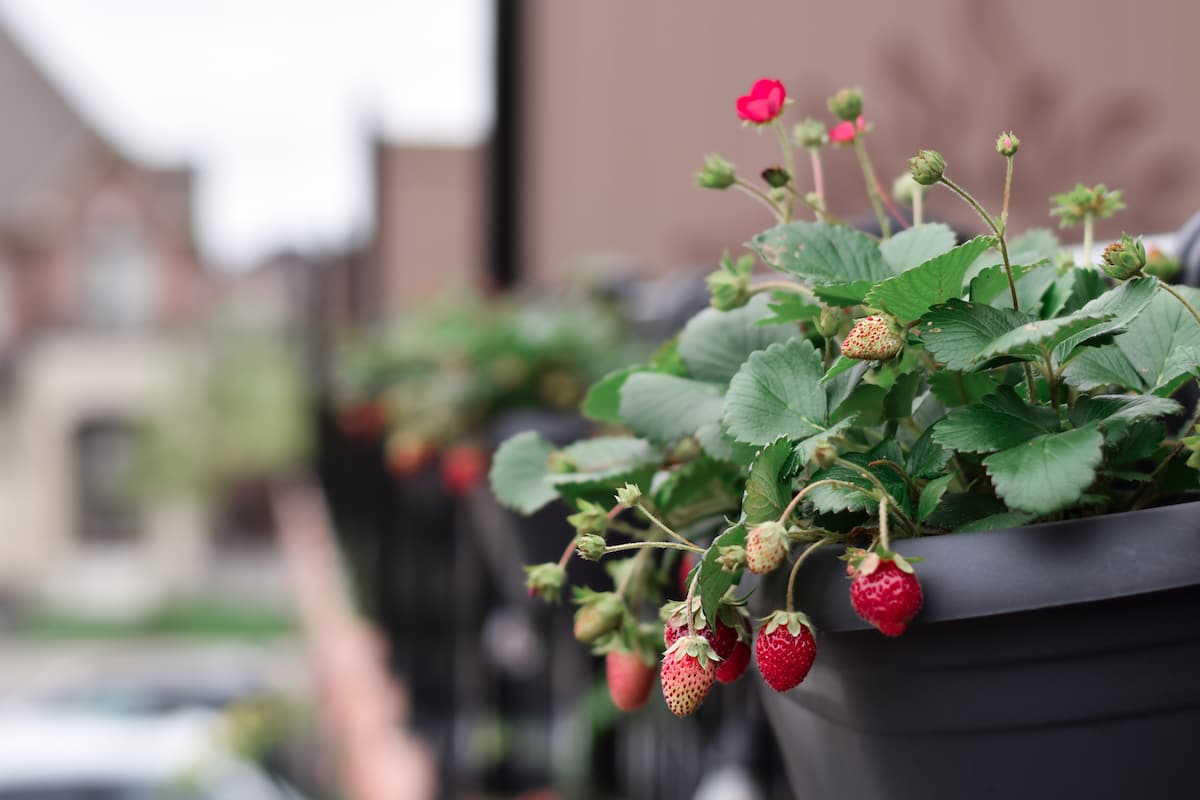Are you interested in or waiting to start growing your fruits and vegetables but don’t have a lot of outdoor space? Look no further than container gardening! You can cultivate your thriving container garden with the right tools and techniques. Anyone, whether they have a balcony, a small terrace, or just a sunny windowsill kitchen garden, can produce their vegetables and fruits on a small scale with the help of pots and containers.

We’ll guide you through the easy steps to growing fruits and vegetables in pots. Everything from choosing the appropriate containers, soil, and plants to caring for your plants and harvesting your delicious homegrown fruit will be covered.
Growing Fruits and Vegetables Successfully in Pots
Selecting Containers for Fruit and Vegetables in Pots
Look for containers at least 12 inches across to ensure they’re big enough to support your plants. Wooden containers are affordable and beautiful but may only last for a short time as other materials. Self-watering containers are easy to use and require less maintenance. Food-grade plastic or glazed ceramic containers are also great options, but seal terra cotta pots to prevent moisture loss. Use a 5-gallon plastic bucket for a DIY option or repurpose something at home, like a laundry basket or toy bin.
Soil Selection and Preparation for Fruit and Vegetables in Pots
Growing healthy fruits and veggies in pots requires high-quality potting soil. Garden soil should be avoided because it will not drain properly and may introduce weeds or diseases. Look for potting soil that has been created specifically for container gardening like
- 40% peat moss or coconut coir: helps retain moisture and nutrients
- 30% vermiculite or perlite: improves drainage and aeration
- 30% compost or well-aged manure: adds nutrients to the soil.
If your soil lacks fertilizer, apply some organic, granular fertilizer before planting and supplement with liquid fish emulsion or seaweed every few weeks. Composting is also an excellent method to enrich your soil.
Choosing Best Plants for Fruit and Vegetables in Pots
- Lettuce – Lettuce is a great choice for container gardening, especially if you have a shallow container. It’s easy to grow and can be planted in early spring or late fall. Consider taking your containers indoors during cold weather to extend your growing season.
- Tomatoes – Tomatoes are one of the best and most popular plants to grow in containers. Wide varieties, from red to purple to green, are available, so choose the one that best suits your needs. Ensure your tomato plants have plenty of sun and water for optimal growth.
- Peppers – Peppers come in many shapes, sizes, and flavors, making them a versatile and easy-to-grow choice for container gardening. They are the second most popular choice after tomatoes. Peppers can be sweet or spicy and come in many colors.
- Arugula – Arugula is a favorite among gardeners for its sweet and spicy taste. It’s easy to grow in a self-watering container and prefers shade over direct sunlight. Keep the soil evenly moist, and you’ll harvest full-grown arugula in just a few weeks.
- Carrots – Carrots are another root crop that grows well in containers. They’re easy to grow and a great choice for beginners. Ensure your carrots have adequate water, but don’t overwater them.
- Onion – Onions are simple to grow and add to salads and other dishes. You can plant several sets in one container. Just allow at least an inch of space between them for optimal growth.
- Peas – Peas are climbing plant that grows well in containers. They do best in the spring and early fall, and you’ll need to provide them with a trellis to climb as they grow.
- Squash – Summer squash, bush zucchini, and other small squash varieties can be grown in containers. They need fairly deep, nutrient-rich soil to grow successfully. You can sow at least two squash plants per container to harvest them regularly.
- Parsley – Parsley is a herb to grow in containers. It adds flavor to many dishes and only requires partial sunlight, so it can be grown indoors before a window that allows sunlight in. Keep the soil moist, but avoid overwatering.
- Strawberry – Although strawberries need plenty of room to grow, they can also be planted in containers. Choose a sunny spot and consider supplementing with artificial sunlight if necessary.
- Blueberry – Blueberries grow well in containers of sunlight, water, and acidic soil. You can produce a healthy blueberry plant in a container with proper care.
In case you missed it: 12 Mediterranean Herbs to Grow in Your Garden

Planting Your Fruits and Vegetables in Pots
- One plant per pot: This is the easiest way. It’s great for bushy plants like tomatoes, peppers, and eggplants. This method gives plants plenty of space to grow, making managing their health and watering easy.
- Companion planting: Two or more plants are planted in the same pot. This method is based on certain plants helping each other grow. Basil enhances tomato taste and repels pests. Marigolds repel pests, and beans, which fix nitrogen, make good partners.
- Succession planting: Planting numerous crops throughout the season. After harvesting one crop, another is sown. This maximizes harvest and assures fresh produce. It’s ideal for fast-growing cabbage, spinach, and radishes.
- Vertical planting: Plants are grown vertically. This is helpful if you have limited room or want to grow vining plants like cucumbers or peas. Stakes, trellises, and hanging boxes can support growing plants.
- Intensive planting: Planting plants closer together than usual. This method lets you grow more plants if you have a small room. It reduces weeds and retains soil wetness. Overcrowding plants can cause bad growth and disease.
Caring for Your Plants for Fruit and Vegetables in Pots
- Care includes watering. Potted plants need more water, especially in hot weather. Water your plants when the top inch of the soil feels dry.
- Tomato blossom-end rot may occur from soil moisture changes. Instead, use a drip irrigation device or water daily for consistent moisture.
- To avoid this, place your pots in a sunny, south- or west-facing area, ideally against a masonry wall, which can hold and release warmth.
- Fertilizing indoor plants helps them grow and produce. Avoid nitrogen fertilizers when raising tomatoes, peppers, and squash.
- Nitrogen prefers leafy growth over fruiting. Leafy plants like cabbage and basil need nitrogen to grow.
- Fertilizers with a balanced three-number formula, like 10-10-10, should be applied regularly but moderately. Fertilizer is released slowly or quickly in some plant mixes.
Harvesting Your Homegrown Produce Fruit and Vegetables in Pots
The best time to harvest your vegetables and fruits is at their peak maturity. Most vegetables and fruits are ready to harvest when they have reached their full size and have good color. Tomatoes should be harvested when fully ripe and have a deep red color. Beans and peas should be picked when they are tender and crisp. To harvest your produce, use a sharp pair of garden scissors or pruning shears to avoid damaging the plants.
In case you missed it: A Guide to Using Vermiculite in Your Garden

Conclusion
Growing fruits and vegetables in pots is a great way to get healthy food and make the most of your room. By following the easy steps in this guide, you can have a successful container garden and see the results of your hard work.
- Feed Your Flock for Less: Top 10 Tips to Save on Chicken Feed
- Ultimate Guide to Ossabaw Island Hog: Breeding, Raising, Diet, and Care
- Hatching Answers: The Top 10 Reasons Your Chickens Aren’t Laying Eggs
- Eggs and Economics: Breaking Down the Cost of Raising Backyard Chickens
- Defend Your Greens: Proven Methods to Keep Iguanas Out of Your Garden
- Ultimate Guide to Cinnamon Queen Chicken: A Comprehensive Guide for Beginners
- Ultimate Guide to California Tan Chicken: Breeding, Raising, Diet, Egg-Production and Care
- Ultimate Guide to Marsh Daisy Chicken: Breeding, Raising, Diet, and Care
- 10 Types of Chicken Farming Businesses You Can Start for Profits